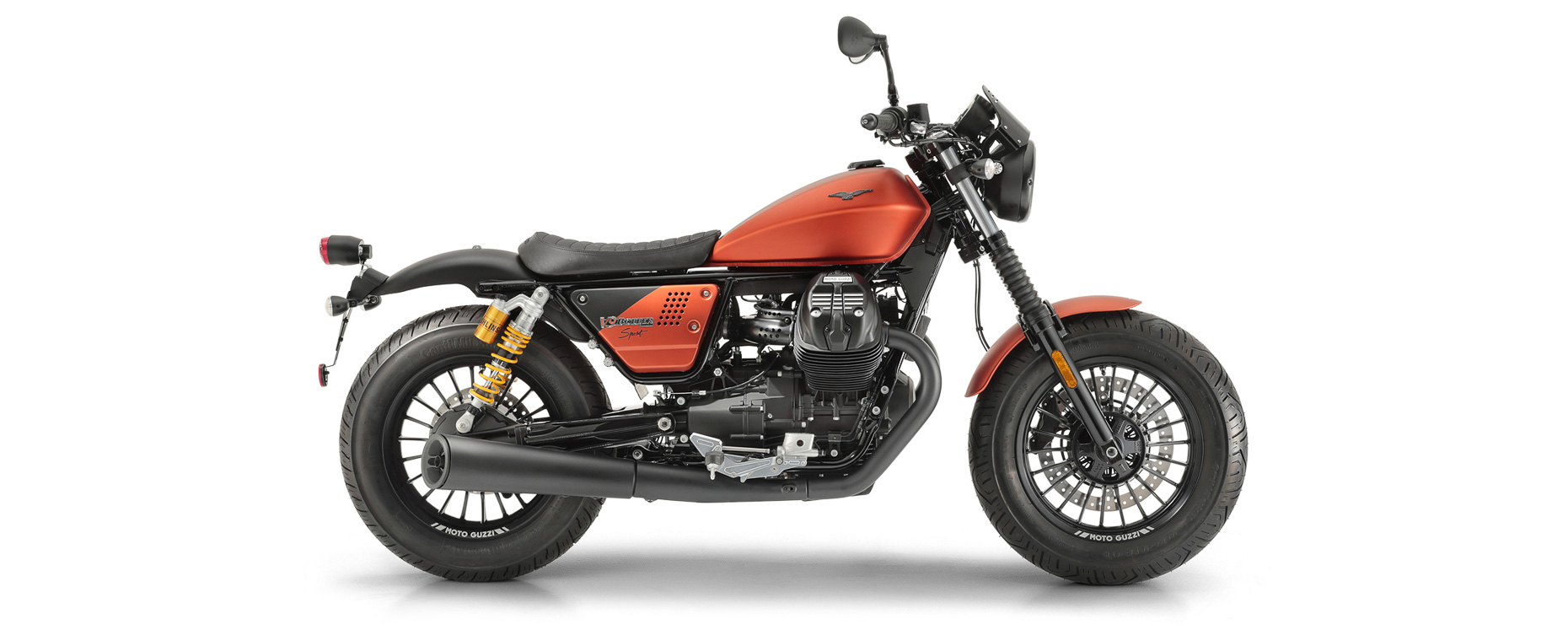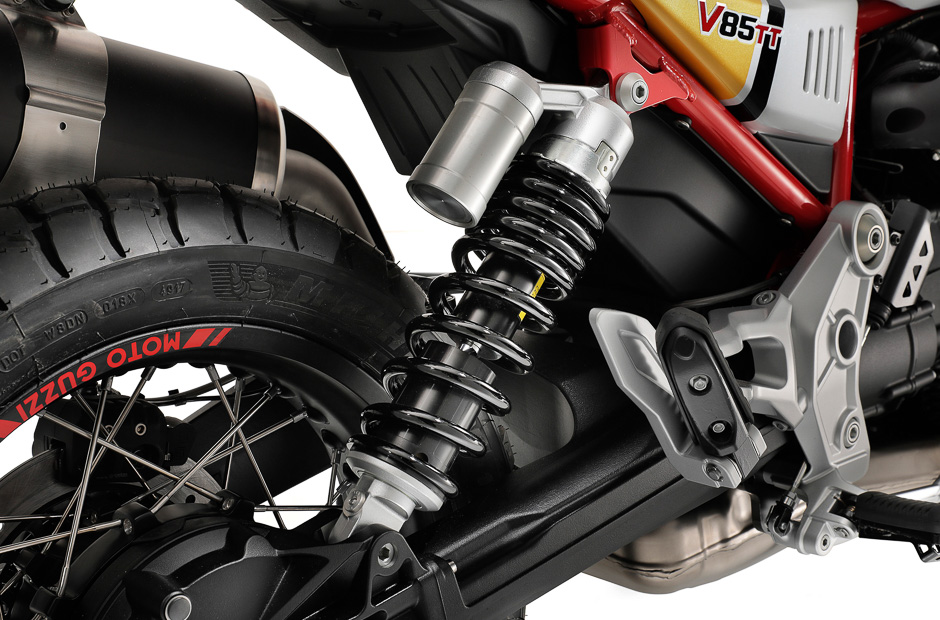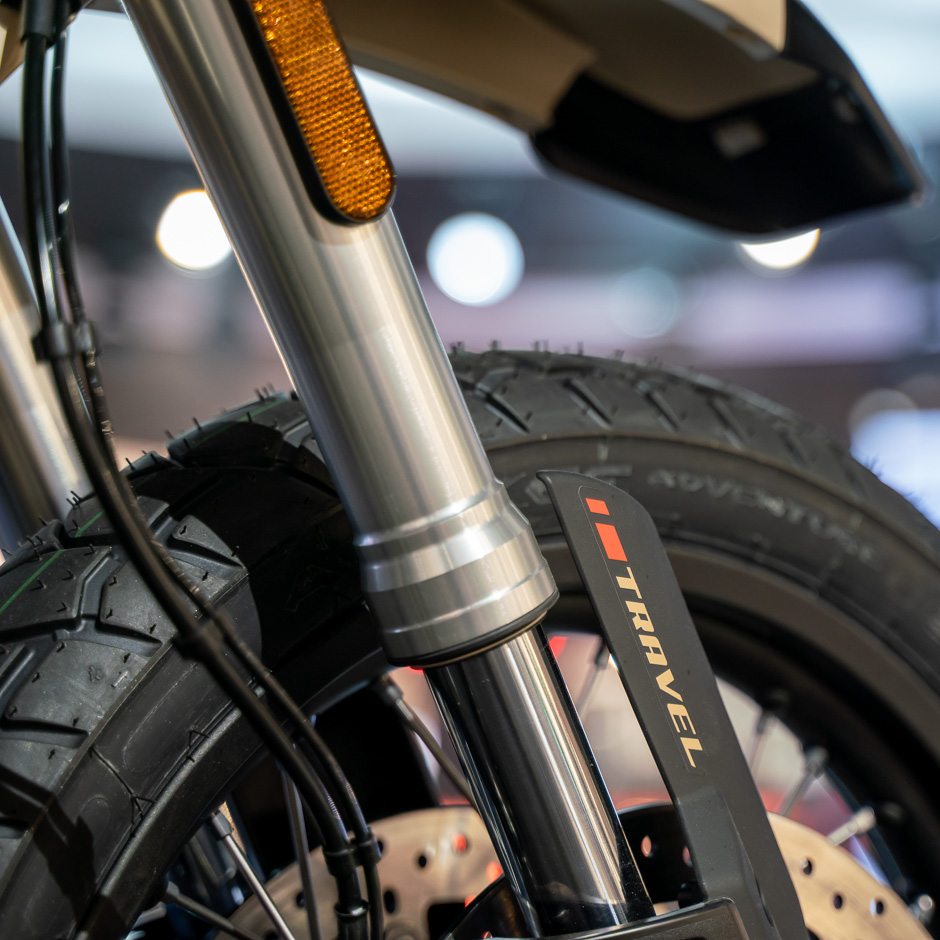You might think that the suspension only serves to make us more comfortable on the motorcycle, but its real task is not so much to make the rider feel comfortable, but to ensure a constant height of the chassis, keeping the wheels in contact with the ground even on the roughest terrain. The front and rear suspension “system” is governed by a delicate interplay of numerous components that interact with each other in perfect balance.
Much of the work that Moto Guzzi does on new motorcycles before production is aimed at finding the best suspension setting. Inevitably, the result is a compromise that can suit many bikers but not all. If you are among the latter, a world of adjustments and tweaks opens up for you, but be careful: before getting started, it’s important to be aware of what you’re modifying!
Though the fork and rear shock absorbers (or monoshock) may seem very different, their operation is substantially similar, as are their basic components: springs and hydraulics.
The springs, more or less soft depending on the case, are used to maintain the setup, or rather to define the height of the front and rear axle, mechanically contrasting the weight of the motorcycle. The hydraulics – i.e. the conduits and valves through which the oil is pushed by the movements of the suspension – serve instead to regulate the compression and rebound speed of the spring by slowing it down. Just think that without oil, the suspension of your Moto Guzzi would tend to jump, swaying repeatedly after every bump. Not a very exhilarating experience. It’s better, then, to know how to adjust it and keep it in perfect efficiency.

Adjustments
What should you think about when you intervene on the adjusters? The ones that act on the preloading of the springs mainly serve to vary the setup and the height of the chassis, for example, when you take on a passenger and you want more support so that the motorcycle doesn’t “sit” on the rear. The fork preload also has a significant influence on front-end control: a more closed (shorter) fork helps with handling, and a more extended (longer) fork improves stability.
If, on the other hand, you are looking for more or less rigidity, you have to work on the hydraulic adjusters, which are what is really responsible for the characteristics of a suspension. In this area, there are more or less sophisticated systems for regulating the hydraulic flows. The adjusters can act on the compression (sometimes separated for high and low speeds) and on the rebound. Deciding to intervene on the hydraulic adjusters requires method and modifications to be made in stages, without acting randomly. It is always better to work with one type of adjuster at a time, taking care to note down how many clicks or screw turns you are making, so that you can return to the initial point. One very common example is when you increase the preloading of the springs and you can adjust the rebound to counteract the greater thrust coming from the spring, or when you are looking for more comfort by opening by a few clicks the compression and rebound on the fork and shock absorber.
Not all of our Moto Guzzis’ original equipment suspensions allow the hydraulic adjusters to be adjusted, but don’t worry: if you feel the need to fit units that allow more sophisticated modes of intervention, the Moto Guzzi Original Accessories Catalogue comes to your rescue, where you can find the sophisticated Öhlins solutions perfectly tailored to the characteristics of our Eagles.
Maintenance
We always take care of the engine, as well as dedicating attention to the wear and tear on our motorcycle’s tyres, but one of the more neglected areas in terms of wear and tear and maintenance is the suspension. As long as our Eagle is under warranty and the coupons are scheduled, everything is fine. But then how many of us are equally attentive about including the suspension in our mileage coupon scheduling?
Our first recommendation, of course, is to consult the service table contained in your motorcycle’s “sacred” owner’s manual, and then rely on the professionals of the official Moto Guzzi service network, especially if you don’t have clear ideas about what you are doing. But since we of Proud Owners are eager for knowledge, we’d like to share with the community some of the necessary tips to make sure that your Eagle is always in tip-top shape.
Let’s start with the basics. Remembering suspension maintenance only when an oil seal starts to leak is a bit like waiting for an engine problem before doing an oil change! The reality is that the suspension wears out and subsequently loses performance. Of course, it can be very difficult to realize this: it happens a bit like with tyres, which wear out gradually as we drive, losing their original properties so slowly that we have time to get used to their deterioration without noticing it. The suspension system is made up of constantly moving parts that work in direct contact with external agents, suffering further wear and tear when used in aggressive environments such as in the rain or in dusty areas.
1) Rear suspension
The first element that ages is the oil of the rear suspension, the component that is under the most stress and is continuously put under pressure to dampen the high stresses on the outgoing and return journeys. The hard work and the high temperatures caused by the friction of the pipes cause the oil to degenerate quickly, causing the additives to evaporate. In addition, the residues of the materials that wear out remain suspended inside, contributing to a further loss of the viscous properties.


2) Fork
The fork too, despite working with less force, is subject to oil ageing, and with its greater stroke suffers from greater wear and tear of the components: first of all, the sliding bushings that allow the stem to slide in the sheath, in jargon called the “Dus”. With normal on-road use, an oil and component check should be scheduled every 10,000 km, an oil change every 40.000 km (check the specific owner’s manual for your model), while for off-road use, even on “all-terrain” twin-cylinder motorcycles, the distances are shortened to 5,000 km in the most extremes cases of use.
And how much do you know about the operation of the suspension of your Moto Guzzi? When was the last time you carried out maintenance on it? Tell us and the other members of the community about it in the comment box.





